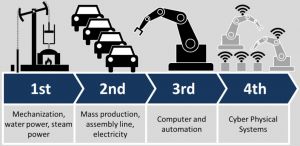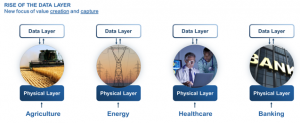Many of us have heard the term, Fourth Industrial Revolution or 4IR (also referred to as Industry 4.0), with local politicians frequently referencing it with great enthusiasm as a panacea for South Africa’s ills and the next phase of the country’s development. However, while some have an idea of its meaning, many people do not have a firm grasp of what 4IR entails. Below, we explain the term and look at the past three industrial revolutions.
Background
The founder and executive chairman of the World Economic Forum (WEF), Klaus Schwab, asserts in his book entitled, The Fourth Industrial Revolution, that there are four distinct periods of industrial revolution throughout history, including the one (4IR) which we are starting now. He describes an industrial revolution as the appearance of “new technologies and novel ways of perceiving the world [that] trigger a profound change in economic and social structures.” Schwab coined the term 4IR in 2016, when it was the theme of the WEF’s meeting in Davos. He argues that a technological revolution is underway which “… is blurring the lines between the physical, digital and biological spheres.”
Figure 1: The progression of the four Industrial Revolutions

Source: Lucidworks
History
Historically, the industrial revolution was a change which occurred when society moved from an agricultural or artisanship economy to a largely urban economy dominated by machine manufacturing. This started in 18th century Britain and spread to other parts of the globe, with the term industrial revolution first popularised by an English economic historian to describe Britain’s economic development from 1760-1840. It was powered by the steam engine’s invention, which enabled new manufacturing processes and led to the creation of factories. Historians refer to this period as the First Industrial Revolution.
Around a century later, the First Industrial Revolution was followed by an age of science and mass production (or the Second Industrial Revolution). During this time rapid advances and mass production in the electricity, steel, oil and automobile industries occurred. Goods that once had to be painstakingly made by hand were now mass produced by machines in huge factories. The telephone, light bulb and internal combustion engine were some of the key inventions of this era.
The Third Industrial Revolution (or Digital Revolution) started in the 1960s, introducing mainframe computing, personal computing, and the Internet to the populace. It also marked the invention of the semiconductor. Analogue moved to digital by dramatically disrupting industries, especially global communications and energy. Electronics and information technology started to automate production, taking supply chains global.
4IR
We are currently at the start of a new era of remarkable technological developments and social change – the age of intelligence or 4IR. Technologies including artificial intelligence (AI), blockchain (a secure, decentralised, transparent way of sharing data, without the need to rely on third-party intermediaries), quantum computing, genome editing, augmented reality, energy capture, storage and transmission, robotics, the Internet of Things (IoT) and 3-D printing, are rapidly changing the way in which people create and distribute value.
Figure 2: AI across industries

Source: Peter Evans, The Centre for Global Enterprise, 2016
In more general terms we can think of it as the collective force behind many services we use daily, for example, a GPS suggesting the fastest route, voice-activated virtual assistants (Apple’s Siri, Amazon’s Alexa, Microsoft’s Cortana etc.), smart refrigerators or even Facebook recognising and tagging your face in a friend’s photo. It also heralds a series of social, political and economic upheavals that will unfold over the course of the 21st century.
Figure 3: Life after Moore’s Law? Quantum computing?

Source: Ray Kurzwell, 2019
4IR is expected to be driven largely by a convergence of digital, biological, and physical innovations (e.g. facial ID recognition, digital healthcare sensors etc.) by building on the widespread availability of digital technologies. As per Moore’s Law, the speed and capability of computers will double every 18 months to two years (since the mid-1960s), because of increases in the number of transistors a microchip can contain. Thus, computers have become smaller and faster at an exponential rate, reducing computing costs by c. 30% p.a. and paving the way towards ubiquitous computing.
Schwab believes these technological changes are drastically altering “how individuals, companies and governments operate, which will ultimately lead to a societal transformation similar to previous industrial revolutions.” Unfortunately, Schwab also predicts that inequality will be the greatest societal concern associated with 4IR, stating “There has never been a time of greater promise, or one of greater potential peril,”.
As with the first three, 4IR is expected to profoundly transform institutions, industries, and individuals. In an interview with CNBC, the WEF’s Head of Technology Policy and Partnerships, Zvika Krieger, highlighted a common theme among each of the industrial revolutions – “the invention of a specific technology that changed society fundamentally.” However, Krieger notes 4IR is different from the Third Industrial Revolution because: i) the gap between the digital, physical and biological worlds are getting smaller; and ii) technology is changing faster than ever. For example, while it took c. 75 years for 100mn people to get access to the telephone, the game Pokemon Go had that many users in less than 30 days.




